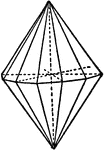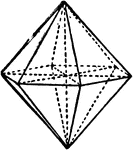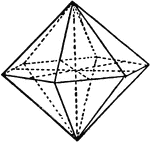Bipyramids
The Bipyramids ClipArt gallery includes 44 images of bipyramids, also known as dipyramids and deltahedrons, which are polyhedrons that connect two identical pyramids of any number of sides at their bases.

Decagonal Bipyramid
Illustration of a decagonal bipyramid. A bipyramid, or dipyramid, is formed by joining two congruent…
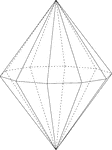
Decagonal Bipyramid
Illustration of a decagonal bipyramid with hidden edges shown. A bipyramid, or dipyramid, is formed…
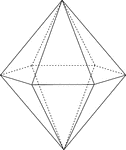
Hexagonal Bipyramid
Illustration of a hexagonal bipyramid with hidden edges shown. A bipyramid, or dipyramid, is formed…
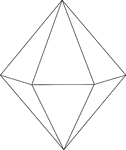
Hexagonal Bipyramid
Illustration of a hexagonal bipyramid. A bipyramid, or dipyramid, is formed by joining two congruent…

Nonagonal Bipyramid
Illustration of a nonagonal bipyramid with hidden edges shown. A bipyramid, or dipyramid, is formed…

Nonagonal Bipyramid
Illustration of a nonagonal bipyramid with hidden edges shown. A bipyramid, or dipyramid, is formed…
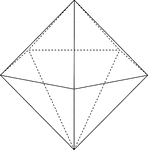
Pentagonal Bipyramid
Illustration of a pentagonal bipyramid. A bipyramid, or dipyramid, is formed by joining two congruent…
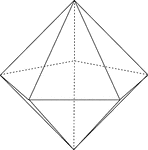
Pentagonal Bipyramid
Illustration of a pentagonal bipyramid. A bipyramid, or dipyramid, is formed by joining two congruent…
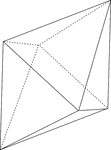
Rectangular Bipyramid
Illustration of a rectangular bipyramid viewed at an angle. A bipyramid, or dipyramid, is formed by…
Rectangular Bipyramid
Illustration of a rectangular bipyramid. A bipyramid, or dipyramid, is formed by joining two congruent…

Rectangular Bipyramid
Illustration of a rectangular bipyramid. A bipyramid, or dipyramid, is formed by joining two congruent…

Septagonal/Heptagonal Bipyramid
Illustration of a septagonal bipyramid. A bipyramid, or dipyramid, is formed by joining two congruent…

Dihexagonal Bipyramid
"...bounded by twenty-four scalene triangles...This form may be considered as a combination of two scalenohedra,…
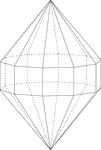
Elongated Decagonal Dipyramid
Illustration of an elongated decagonal dipyramid that is formed by elongating a decagonal bipyramid…

Elongated Decagonal Dipyramid
Illustration of an elongated decagonal dipyramid that is formed by elongating a decagonal bipyramid…

Elongated Decagonal Dipyramid
Illustration of an elongated decagonal dipyramid that is formed by elongating a decagonal bipyramid…
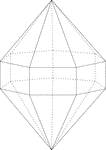
Elongated Heptagonal/Septagonal Dipyramid
Illustration of an elongated heptagonal/septagonal dipyramid that is formed by elongating a heptagonal…
Elongated Heptagonal/Septagonal Dipyramid
Illustration of an elongated heptagonal/septagonal dipyramid that is formed by elongating a heptagonal…

Elongated Heptagonal/Septagonal Dipyramid
Illustration of an elongated heptagonal/septagonal dipyramid that is formed by elongating a heptagonal…
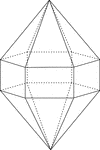
Elongated Hexagonal Dipyramid
Illustration of an elongated hexagonal dipyramid that is formed by elongating a hexagonal bipyramid…

Elongated Hexagonal Dipyramid
Illustration of an elongated hexagonal dipyramid that is formed by elongating a hexagonal bipyramid…
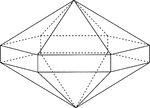
Elongated Hexagonal Dipyramid
Illustration of an elongated hexagonal dipyramid that is formed by elongating a hexagonal bipyramid…
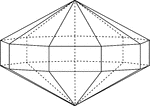
Elongated Nonagonal Dipyramid
Illustration of an elongated nonagonal dipyramid that is formed by elongating a nonagonal bipyramid…

Elongated Nonagonal Dipyramid
Illustration of an elongated nonagonal dipyramid that is formed by elongating a nonagonal bipyramid…
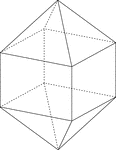
Elongated Square Dipyramid
Illustration of an elongated square dipyramid that is formed by elongating a square bipyramid by inserting…
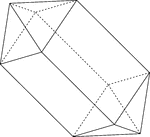
Elongated Square Dipyramid
Illustration of an elongated square dipyramid that is formed by elongating a square bipyramid by inserting…

Ditetragonal Bipyramid
"This is the general form; it is bounded by sixteen scalene triangles, and all the indices are unequal."…
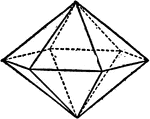
Hexagonal Bipyramid
"...bounded by twelve isosceles trianes each of which are equally inclined to two planes of symmetry."…

Orthorhombic Bipyramids
"This is the general form and is bounded by eight scalene triangles." -The Encyclopedia Britannica 1910

Orthorhombic Bipyramids
"This is the general form and is bounded by eight scalene triangles." -The Encyclopedia Britannica 1910
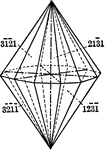
Dihexagonal pyramid
"The dihexagonal pyramid is a form of twenty-four isoceles triangular faces, each of which intersects…

Ditetragonal pyramid
"The ditetragonal pyramid is a form composed of sixteen isoceles trianglular faces, each of which intersects…
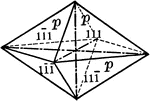
First order pyramid
"The pyramid of the first order is a form consisting of eight isoceles triangular faces, each of which…
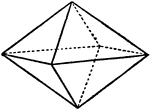
Tetragonal Bipyramids
A tetragonal bipyramidal crystal where the vertical axis is shorter than the horizontal axes.

Tetragonal Bipyramids
A tetragonal bipyramidal crystal where the vertical axis is longer than the horizontal axes.

Tetragonal Bipyramids of the First Order
Represents the relation between the tetragonal bipyramid of the first order when the indices are {111}.
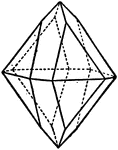
Tetragonal Bipyramids of the Second Order
Represents the relation between the tetragonal bipyramid of the first order when the indices are {111}.
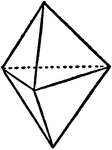
Trigonal Bipyramid
"...bounded by six isosceles triangles...indices as in the hexagonal bipyramid." -The Encyclopedia Britannica…
